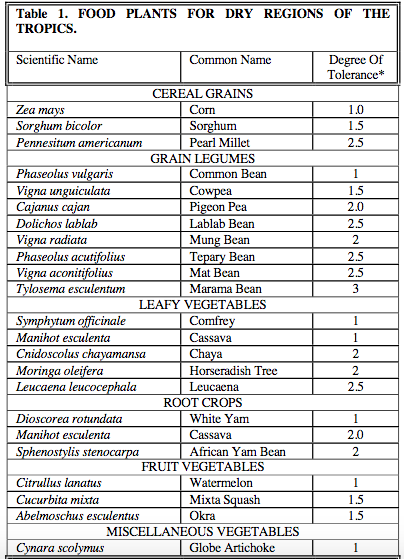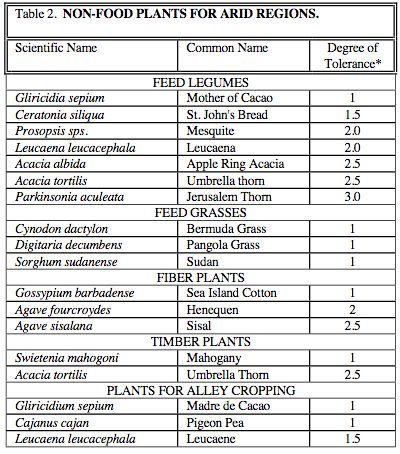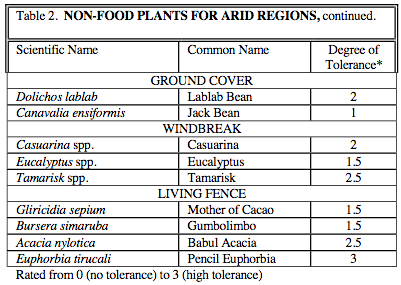Optimizing Crop Cultivation and Irrigation
Terrascope 2022 has mainly focused on increasing water access for households rather than agriculture, especially since most Diné that the class have spoken to prioritize addressing water access in homes before farms (Water usage for agriculture is outlined on our Current Status page). Still, this page presents ideas on how to conserve water in small farms with sources to learn more about how to implement these; most of these strategies function on an individual basis and thus may be put into use by the individual farmer.
Traditional Navajo farming, which involves using floodwater techniques – which are reliant on snowmelt and rain/storm water irrigation – already effectively uses less water than other farming styles common in the U.S. and has been used for centuries. Dryland farming, which includes methods from around the world, involves unirrigated agriculture and is a major methodology that can be used to conserve water. Because of increasing demands for water and declining water availability, we discuss some elements of dryland farming that could fit well into traditional Navajo floodwater farming and supplement the conservation of water in these practices. We also discuss other techniques not associated with dryland farming that involve slight changes to existing practices that are already used on the Nation. Utilizing traditional agricultural practices supplemented with these other methods may be a very effective way to conserve water on small farms, which will be increasingly important as climate change affects crop yields and growth. Learn more about the effects of climate change on agriculture.
The maintenance of soil quality is integral to conserving and efficiently utilizing water in farming with minimal extra costs. Methods that tend to retain soil moisture and quality also tend to reduce water use and maximize water absorption. Preserving water, if farmers have higher amounts of funding, would involve installing drip irrigation structures, which is one of the most efficient water reduction irrigation systems (Arroyo, 2018). However, this solution requires routine maintenance and upkeep of irrigation structures to limit water loss and promote efficient water transport, which would necessitate either government or individual funding. Funding from the government could be used to incentivize farmers to use clear fallowing, (the practice of leaving a field unplanted for a season) which would allow the soil to regain and retain vital nutrients that maintain soil quality and maximize water use.
Table detailing crops in the Navajo Nation from (USDA Agriculture Census, 2012)
Agriculture in the Navajo Nation is comprised of mainly NAPI (Navajo Agricultural Products Industry) and many small family farms, and the majority of farms make less than a thousand dollars a year, growing primarily corn, squash, and other fruits and vegetables. Visit the Current Status page to learn more about NAPI and why it was not a focus of our project. Although one of the best ways to reduce water use, introducing new irrigation methods is expensive and not feasible for many Diné
Current Crops and Techniques
The table below outlines crop acre/farm distributions from 2012, with corn, squash, vegetables, and watermelons being planted on the most farms.
This shows most grown crops in the Navajo Nation (USDA agriculture census, 2012)

As can be seen in the table above from Creswell and Martin, some crops currently being planted, such as a corn variety and watermelon have low drought tolerance. The degree of tolerance refers the crop’s resistance to drought. The scale ranges from 1-3, with a score of 3 indicating the highest drought tolerance. If some of these drought-intolerant crops are replaced with higher resistance, native crops, water requirements could be reduced.
Traditional agriculture on the reservation involves floodwater farming with specifications of certain things like how seeds are planted/spread out and when to do so. Floodwater farming uses water from snowmelt as well as spring-summer rainstorms (Smithsonian, 1954) Others on the reservation use irrigation methods, such as NAPI, which uses sprinkler irrigation (US Department of the Interior, 2018).
Dryland Farming Techniques
Because land on the reservation is very dry and experiences low amounts of rainfall, farming requires unique techniques that conserve water and maintain the water retention ability of the soil. Dryland farming is a methodology that can be applied to areas that have minimal amounts but still experience rainfall. We researched three central aspects of dryland farming that can be relatively easily applied to traditional floodwater farming: strip cropping, crop rotation, and reduced tillage.
Strip Cropping
Dryland farming involves strip cropping, the practice of planting crops that either allow or disallow soil erosion and exposure in alternating zones to maintain soil integrity. Soil integrity involves soil structure, soil compaction, nutrient degradation, and soil salinity. Maintaining soil integrity increases water absorption rates – with amounts dependent on a number of factors – and decreases desertification risk (World Wildlife Fund, 2018). Reducing soil erosion plays a key role in effectively absorbing water and maintaining healthy crops.

Three methods of strip cropping; these methods preserve soil integrity and reduce water runoff. Strip cropping without attention to contours of the land and/or prevailing winds may be slightly less effective but is simpler to use and can still greatly reduce soil erosion. (Gupta, 2016)
Crop Rotation
Dryland farming also may involve crop rotation, which allows soil the chance to retain more moisture, necessitating less water input by rotating “moisture intensive” and “moisture conserving” crops (Creswell, Martin, 1998). Additionally, crop diversification controls pest populations that reduce agricultural yield. Rotation techniques can be used with strip cropping, using different strips to rotate crops through and these function well to conserve water if they do so. Alternatively, they can be used as their own technique. A sample 5 year rotation (provided by Van Es and Magdorf), not necessarily applied to strip cropping, which could possibly be applied in offset years in conjunction with other families so that each family has access to a variety of vegetables is as follows:
“Year 1. Sweet corn followed by a hairy vetch/winter rye cover crop
Year 2. Pumpkins, winter squash, summer squash followed by a rye or oats cover crop
Year 3. Tomatoes, potatoes, peppers followed by a vetch/rye cover crop
Year 4. Crucifers, greens, legumes, carrots, onions, and miscellaneous vegetables followed by a rye cover crop
Year 5. (If land is available) oats and red clover or buckwheat followed by a vetch/rye cover crop”
An emphasis on traditional Diné crops can still be retained and will function quite well with rotations such as these. There have been recent movements in the Diné community to move back towards farming traditional crops, for both health and cultural reasons. For instance, the Utah Diné Bikeyah organization has started a Traditional Foods program which aims to “to preserve and protect the cultural and natural resources of ancestral Native American lands and bring healing to the Earth” (Utah Diné Bikeyah, 2018) by encouraging use of traditional crops. Using traditional crops with an effective crop rotation system may represent a good way to connect back to historical agricultural roots, improve nutrition, and preserve soil quality.
The potatoes they mention can be exchanged for the Four Corners potato, a variety dating back in indigenous history, as well as traditional squash varieties for the squash mentioned in the sample rotation. These indigenous varieties tend to be more drought resistant. Choosing drought resistant crops may also help prevent water loss.
A great resource that provides both factsheets about seeds native to the greater Southwest region and an opportunity to buy these seeds – at reduced or no cost to native Americans through “Native American Seed Request” – is Native Seeds/SEARCH. Native Seeds/SEARCH focuses on biodiversity conservation and providing arid-climate adapted seeds to the people of the region, recognizing the importance of responding to climate change, in order to “nourish a changing world”.
Learn more about the Native Seeds program and different traditional crop options
The tables below (click on table for source) detail some plants (indigenous and non-indigenous) that can be used as crops for food, feed crops, cover crops (discussed later), windbreak, and living fences that have their drought tolerance, with 0 being no tolerance and 3 being very tolerant.



Reduced Tillage
Another aspect of dryland farming techniques involved dryland tillage systems. Tilling is a step in agriculture in which soil is agitated and turned over in order to encourage plant growth. However, it exposes unprotected soil, which decreases soil quality, encourages topsoil loss and decreases the ability of soil to hold water.
Harold Van Es of Cornell University and Fred Magdorf of University of Vermont claim that “transition to tillage systems that increase surface cover and reduce disturbance is probably the single most effective and economical approach to reducing erosion” (Van Es, Magdorf, 2009). Increasing surface cover mentioned here refers to the use of cover crops, discussed later. Reducing erosion reduces both soil and water loss, and systems that help do this are called “reduced tillage” systems which involve different techniques that try to reduce the total amount of farmland being intensively tilled. Reduced tillage systems can vary in their tilling levels and may even become no tillage systems. One example of an intermediate system that is easily applicable but more reliable than no tillage, given by a New Mexico State University publication, involves only the planted rows in zoned systems being intensively tilled and soil in between remaining untouched, reducing the total amount being intensively disrupted. (Idowu, Marsalis, Flynn, 2012)
Other Water-Conserving Farming Techniques
Other unique farming techniques have proven to significantly reduce water use and aid in maintaining soil quality.
Reducing transpiration
Farmers can reduce transpiration (cellular loss of water) in plants by choosing plant varieties with less leaf surface area, which can be seen simply by looking at different phenotypes, or the physical characteristics, of the desirable plant species.
Crop alternation and irrigation reduction
Timing dependent methods can include alternating crops and reducing irrigation during less drought sensitive times. Alternating crops to avoid growing in the hottest period of the year (in late summer) decreases evaporation (for instance, using leafy greens in the winter and durum wheat, spring melons, and Sudan grass in early summer), which has been effective in the climatically similar Yuma region of Arizona (Lahmer, Eden, 2018). Reducing irrigation during less drought sensitive times (on a crop by crop basis) is an efficient way to use water only when it is needed most. The chart below details some of these drought sensitive times for specific crop species (Idowu et. al., 2012):
Cover Crops
Another very beneficial method of farming sustainably with regards to water and soil is the use of cover crops. Examples of good cover crops include winter rye and hairy vetch, and these are even more effective when they are grown, cut, and mulched. Cover crops are able to reduce erosion and increase water absorption in several ways. Roots bind to the soil and help hold soil in place, effectively safeguarding against erosion, and their presence decrease soil crusting, which limits water infiltration into the soil and can contribute to runoff. Finally, it helps to donate more organic material back into the soil, as it is not used for consumption (Magdorf, Van Es, 2009) Learn more about the use of cover crops in this handbook.

Farmers holding their ryegrass cover crop
Current Farm and Ranch Resources on the Navajo Nation
NAPI (Navajo Agricultural Products Industry)
NAPI is a large farming enterprise that was established by the Navajo Nation Council to provide employment and generate income for the reservation, and 95% of its employees are Navajo. It has 72,000 developed acres and in addition to providing jobs, it educates the community by providing internships and scholarships.
NNDA (Navajo Nation Department of Agriculture)
The NNDA provides technical support to Navajo farmers and ranchers and supports them with regulatory agencies. They also coordinate policy and program planning.
These are not the only agriculture initiatives on the reservation, but they represent major players in the agricultural sector. Utilizing its resources and outreach, an effective way to reduce overall water use would involve the NNDA potentially starting training programs or releasing user-friendly pamphlets – especially in both Navajo and English languages, which unfortunately this site does not have both of – to help farmers adapt some of these techniques to their own farms.
Helpful resources
The Building Soils for Better Crops handbook written by Fred Magdorf and Harold Van Es is a great general resource to learn more about soil management techniques.
The USDA provides a practice standard document relevant to considerations of strip cropping that may aid in the understanding of its different elements.
Randy Creswell and Dr. Franklin W. Martin’s 1993 publication (revised in 1998) entitled Dryland Farming: Crops & Techniques for Arid Regions provides useful and in depth information on dryland farming techniques and furnishes topics with detail such as strip cropping, plowing depth, planting distances, temperature ranges, etc.
The New Mexico State University publication “Agronomic Principles to Help with Farming During Drought Periods” offers insight into agricultural drought management practices that may actually be helpful in times without drought as well.
“The Arroyo: Water and Irrigated Agriculture in Arizona”, published by the Water Resources Research Center College of Agriculture and Life Sciences of University of Arizona, provides information on the history of irrigated agriculture in Arizona including indigenous agriculture, information about groundwater usage, and helpful information about irrigation efficiency and water conservation ideas.
These fact sheets/pages present some primary knowledge on soil erosion and degradation, agriculture among the Hopi tribe (of which principles connecting to climate may be utilized for the Navajo), and a look into the Utah Diné Bikeyah organization’s traditional foods program.


